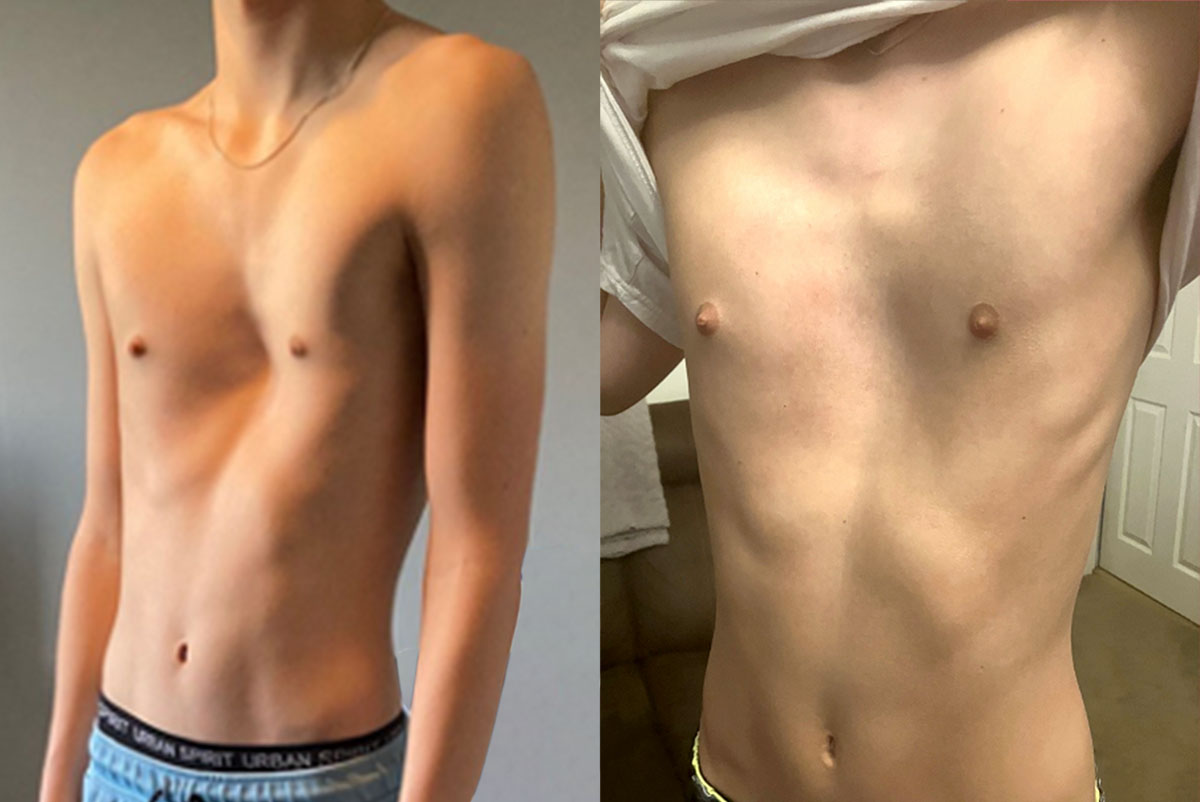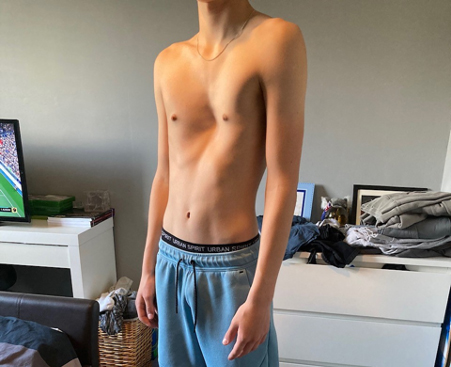
Oliver's chest before treatment (left) and after 6 months of vacuum bell therapy treatment (right)
17 July 2023
Oliver, who is now 17 years of age, has severe pectus excavatum with associated rib flaring, the hollow in his chest was measured to be 5.7cm prior to beginning LOC’s non-surgical treatment with the vacuum bell. After only 6 months it has been reduced to 2.5cm.
Before finding LOC, Oliver and his parents had a number of unfortunate experiences when seeking treatment for his sunken chest on the NHS. They first became aware of his condition when his older brother burst in on Oliver when he was in the bath to find him sobbing, saying ‘I am abnormal’. His mother, Rachel, recalls: “We took lots of pictures and managed to get him seen by the paediatric department at our local hospital (which was still in lockdown mode).
They said there was not a lot they could do about it, it might be Marfans Syndrome and then followed with the apology that there was a waiting list for the genetic testing required until 2024. Oliver was referred to a thoracic surgeon who did not actually take the time to examine him or even look at his file and said he would just have to live with the condition, or alternatively pay £30,000 for surgery.”

Oliver's chest before treatment
Not surprisingly, Oliver’s parents were keen to find an alternative solution which is how they came to see Anna Courtney, the clinical lead at LOC. First, Rachel spoke to Anna via Facetime, LOC provides the opportunity for initial free virtual pectus consultations as a means of explaining our treatment package and answering any initial questions prior to a face-to-face appointment.
Rachel exclaims “What a difference…… at our face-to-face appointment, Anna spoke directly to Ollie, she said we can fix it, we can’t guarantee a 100% improvement but we can try to work together to make a significant difference but you must play your part by embracing the specified wearing regime. By this stage, Oliver was absolutely committed to whatever was required to make the treatment a success. We walked away with his vacuum bell and bespoke rib flaring brace with a spring in our step – the same-day service was another pleasant surprise.”
The Vacuum Bell uses a silicone cup and a vacuum pump to create an area of pressure over the indented part of the chest. The patient then uses the hand pump to remove air out of the device which in turn creates a vacuum that pulls the sternum and ribs outward. With continued use, this pressure gently reshapes the chest and guides the sternum back to a more normal position.
“It has made a massive difference to our family”, says Rachel; “Oliver had really closed down in the months before we found LOC, he used to play football regularly with a group of friends and he had given that up. He now goes to the gym four times a week, he feels different, more confident. He has got a trial with our local football club, something he would not have even contemplated a few months ago. He has been brilliant about using his vacuum bell, wearing his brace and doing his breathing exercises and I have no doubt that his commitment has contributed to the success of his treatment, and I haven’t had to nag him!”
If your child is concerned about their chest shape, please get in touch to book your free virtual pectus appointment today.
This depends on several factors; the position of the chest wall deformity, its severity, the flexibility of the chest, the kind of results wanting to be achieved and the age of the person undergoing treatment for pectus excavatum or pectus carinatum.
Early adolescence (roughly between the ages of 12-16 years old) – is an optimum age to start treatment, given that the chest is still maturing, and flexible, permanent correction is more easily achievable. Once bracing treatment is complete and a patient has stopped growing, the deformity will not return. For younger pectus patients, conservative bracing is used to keep a deformity from worsening and can help them to avoid surgery in later life.
For older pectus patients (between the ages of 20 to 30) results can be harder to achieve, as the costal cartilage hardens into the bone as a person matures. Over the years we have successfully treated many adults for both pectus excavatum and pectus carinatum and active adults with flexible chests can expect good results.
Again, this hugely depends on what a patient wants to achieve from treatment; whether that’s avoidance of surgery, improvement in the appearance of the chest shape, reduction in rib flaring etc. All these goals are taken into consideration during your first consultation. While there are no serious health risks of having pectus carinatum or excavatum – beyond the cosmetic – for many patients and parents, treatment outcomes involve improving confidence and self-esteem. During our 2018 Pectus Patient Survey, 92% of pectus carinatum patients surveyed said that treatment had a ‘major improvement’ or ‘an improvement’ on their social life.
You can read the results of our 2018 Pectus Patient Survey and quality of life questionnaire here.
Regular reviews are part of the treatment programme, preferably in clinic with one of our specialist orthotists, or via Skype consultations.
The number of appointments needed will vary from patient to patient but as a general rule, younger pectus patients who are growing at a faster rate will need to be seen more regularly for check-up appointments. This is to ensure that the brace fits well and is guiding the chest into the correct position as growth spurts occur. For other patients, this can be scaled back according to their individual needs and demands.
Regular appointments are beneficial for assessing progress, checking for signs of rubbing and determining whether another brace is needed. Appointments are also good for checking patient compliance to brace wearing and the breathing and exercise programme. At each appointment, we make time for patients to see our physiotherapist to fine-tune their exercise programme and check to see how a patient has been managing with the current programme.
We always advise coming in for appointments whenever you have any concerns about the brace or treatment programme, especially if a brace is rubbing or not fitting correctly. At the London Orthotic Consultancy, we have treated numerous international patients that have benefitted from specially designed braces that leave room to accommodate for growth and that can be adjusted remotely. Follow-up appointments for international patients are conducted via Skype.
This is a very common concern for patients considering treatment; in general, the dynamic chest compressor brace is easy to conceal if you are wearing a loose-fitting shirt for school or work. If you are wearing two chest braces – one for the main deformity and the other for rib flaring – then this may be more noticeable, especially under a t-shirt. Normally loose-fitting clothing will conceal the brace, though it’s likely it will be seen through tight-fitting clothes.
It is really important to continue exercising while going through bracing treatment. Exercise is fundamental to keeping the chest wall flexible. Our treatment programme incorporates a daily exercise routine of around 30-40 minutes of stretching using yoga poses, resistance bands, deep breathing exercises and general muscle stretches. Deep breathing exercises allow the lungs to expand against the chest wall, pushing it outwards.
Exercising with the brace on in the later stages of treatment can also make the chest correction more stable and permanent.
Swimming is one of the best forms of exercise to complement bracing treatment, as the body positions required to swim imitate the resistance band training designed to stretch the chest and increase its flexibility. Some swimming strokes are better for this than others, please check with your clinician. The brace should always be removed for contact sports and for swimming.
For most patients, one brace is often all that is needed to achieve a desired level of correction. They are each designed to last the duration of treatment and accommodate any growth that may occur in that time. Some patients have benefitted from having two braces – one to treat the main deformity and the other to treat rib flaring. For some pectus excavatum patients, having a brace apply pressure to the ribs – in addition to vacuum bell therapy – can greatly reduce the appearance of the depressed sternum area of the chest, forcing it upwards and outwards into a more corrective position.
If you are worried about your chest shape, or your child’s chest shape, then get in touch for a free Skype consultation with one of our pectus specialists who can assess their chest and discuss treatment options. We are always happy to communicate with local GPs, thoracic surgeons and consultants if a patient approaches us for bracing treatment after considering other options.